Kimbei, Kusakabe (36 results)
Product Type
- All Product Types
- Books (25)
- Magazines & Periodicals
- Comics
- Sheet Music
- Art, Prints & Posters
- Photographs (11)
- Maps
-
Manuscripts &
Paper Collectibles
Condition
- All Conditions
- New
- Used
Binding
- All Bindings
- Hardcover (4)
- Softcover
Collectible Attributes
- First Edition
- Signed
- Dust Jacket
- Seller-Supplied Images (22)
- Not Printed On Demand
Seller Location
Seller Rating
-
Condition: Fine. Number of books: 1.
-
Weaving silk. [Studio caption]
Published by [1870s -1890s]., 1870
Seller: Asia Bookroom ANZAAB/ILAB, Canberra, ACT, Australia
Hand-coloured albumen print 20.5 x 26.5 cm tipped to the same-sized card and mounted on an album page 30.3 x 41.7 cm, the studio caption in the negative to the lower right, the print wrinkled with discolouration to the left edge and lower corner, two small tears neatly repaired, but with good tone. From the estate of the late collector and scholar Arthur Hacker with his pencilled catalogue inscription (in Japanese).
-
PHOTOGRAPH OF A YOUNG JAPANESE WOMAN AT THE SILK SPINNING WHEEL.
Seller: RARE ORIENTAL BOOK CO., ABAA, ILAB, Aptos, CA, U.S.A.
[Yokohama n.d. ca 1880, Kusakabe Studio]. A single albumen photograph, 9 x 13.5 cm.,mounted on a stiff card with orange silk edges, very good, hand-colored. UNUSUAL ITEM . * THE PHOTOGRAPHER: Kusakabe Kimbei [1841-1934] was a well-known Japanese photographer, who served the foreign community in Yokohama. He created lovely photographic albums with scenery, studio images of posed Japanese men and women and a wide variety of other souvenir albums. His work was of a high quality and an interesting nature. * Kusakabe was a very unique Japanese photographer who understood Western photographic principals, but stuck to his native Japanese style and tradition of capturing native Japanese subjects with great skill. . Kusakabe likely apprenticed with both Beato and Stillfried as a photograph colorist. In 1885 he managed to acquire a number of Beato and Stillfried negatives which were reprinted and sold in his albums. Kusakabe being located on the main street in Yokohama had many foreign clients who purchased his albums. . His landscapes captured what 19th century Japan was truly like. His portraits also reflect a "natural" beauty and quality not found in the work of other Japanese photographers of the time, even though many were posed. . Kusakabe also sold photographs by the famous Nagasaki photographer Ueno Hikoma. . *** THE IMAGE: This stunning image, shows a young Japanese farm girl in a rough Kimono, with a cloth covering her head to keep the lint off. On her knees she sits Japanese style on a Tatami mat, while she rotates a wooden spinning wheel with her right hand, while she feeds the thread with her left. . Nicely and delicately colored in pastels. A clear and fine image, minor fading to the background, image is strong and sharp. *** .
-
KAGO PLANQUIN, TRAVEL CHAIR. A Hand-Colored Albumen Photograph.
Seller: RARE ORIENTAL BOOK CO., ABAA, ILAB, Aptos, CA, U.S.A.
[Yokohama ca. 1880, Kusakabe]. A single hand-colored photograph, 27.5 x 21 cm., very good, mounted on a stiff paper right margin has hand-colored floral pattern. OBSCURE . *** Kusakabe [1841-1934] was a very unique Japanese photographer who understood Western photographic principals, but stuck to his native Japanese style and tradition of capturing native Japanese subjects with great skill. His portraits also refl- lect a "natural" beauty and quality not found in the work of other Japanese photographers of the time, even though many were posed. . This excellent period photograph is a classic. It shows four Kago or palanquin carriers holding a young Japanese girl who holds an umbrella before the Hafuya Hotel. The photograph has a caption in English in the lower right corner,with the number B86. . The coolie carriers dont look too happy in fact one at the rear looks completely exhausted while Kusakabe takes the photograph. . Delicately hand-colored with accents, but mostly in original black and white.
-
[Japan ca.1880]. A large matted photograph with lower right inset English caption and number 1413, ca. 26.5 x 20.5 cm., excellent pastel color, sharp image, fine work. Likely the actual photographic work of Ueno Hikoma of Nagasaki. RARE ! . * WHO IS THE PHOTOGRAPHER KUSAKABE KIMBEI: . Kusakabe Kimbei [1841-1934] was a well-known Japanese photographer, who served the foreign community in Yokohama, operating from ca. 1881-1913. He created lovely photographic albums with scenery, studio images of posed Japanese men and women and a wide variety of other souvenir albums. His work was of a high quality and an interesting nature. . Kusakabe was a very unique Japanese photographer who understood Western photographic principals, but stuck to his native Japanese style and tradition of capturing native Japanese subjects with great skill. . Kusakabe likely apprenticed with both Beato and Stillfried as a photograph colorist. In 1885 he managed to acquire a number of Beato and Stillfried negatives which were reprinted and sold in his albums. Kusakabe being located on the main street in Yokohama had many foreign clients who purchased his albums. . His landscapes captured what 19th century Japan was truly like. His portraits also reflect a "natural" beauty and quality not found in the work of other Japanese photographers of the time, even though many were posed. . Kusakabe also sold photographs by the famous Nagasaki photographer Ueno Hikoma. . There is common confusion regarding the works of both Kusakabe Kimbei and those of Kashima Seibi [1866-1924]. Kashima was known as the photographer of a book by Angus: JAPAN: The Eastern Wonderland, & volume seven of the PRACTICAL PHOTOGRAPHER. He is often & wrongly referred to as "Kajima." He also had a studio and his images were often re-used by K. Ogawa as Kashima helped finance Ogawa's collotype [photo] business. See Bennett below for more biographical and other details on these photographers. *** THE IMAGE: . This is a superb image, the view of Osuwa temple and its foreground area. Shows a bronze horse, granite "Fu-dogs" and the massive temple gate. There are six Japanese gentlemen, Kimono-clad pilgrims four with black bowler-type foreign popular hats of the period. All wear they typical and traditional Geta [a kind of wooden sandal with tall cleats]. . Nicely done, a classic ! *** REFERENCES: The following are some useful bibliographies to consult for more information on this album and Japanese early photography in general: * BENNETT, Terry. EARLY JAPANESE IMAGES . BENNETT, Terry. OLD JAPANESE PHOTOGRAPHS: COLLECTORS' DATA GUIDE. * H. Bayou; FELICE BEATO ET L'ECOLE DE YOKOHAMA. JAPANISCHE PHOTOGRAPHIE 1860-1929. * H. Cortazzi: JAPAN CAUGHT IN TIME. * [Feliz Beato/R. von Stillfried]: ONCE UPON A TIME: Visions of Old Japan from the Photos of Beato and Stillfried & the Words of Pierre Loti. * Claudia G. Philipp et al: FELICE BEATO IN JAPAN: Photographien zum Ende der Feudalzeit 1863-1873. * C. Worswick: JAPAN PHOTOGRAPHS 1854-1905. * Philipp March & Claudia Delank: THE ADVENTURE OF JAPANESE PHOTOGRAPHY 1860-1890. * LA LEGGENDA DI UN IMPERO: Felice Beato e la scuola fotogarfica di Yokohama alla scoperta del Giappone 1860/1900 for more useful details, valuable images and information. * ans of this and most of our items are posted to our website.
-
[Yokohama 1880, Kusakabe]. A single albumen photograph, 18 x 22 cm., very clean, #1038 in lower right corner, delicately hand-colored in pastels and hues, a solid copy in very nice condition. . *** **** *** . . AN EXCELLENT PORTRAIT OF A JAPANESE VEGETABLE MONGER . *** WHO WAS THE PHOTOGRAPHER KUSAKABE KIMBEI: Kusakabe Kimbei [1841-1934] was a well-known Japanese photographer, who served the foreign community in Yokohama, operating from ca. 1881-1913. He created lovely photographic albums with scenery, studio images of posed Japanese men and women and a wide variety of other souvenir albums. His work was of a high quality and an interesting nature. . * Kusakabe was a very unique Japanese photographer who understood Western photographic principals, but stuck to his native Japanese style and tradition of capturing native Japanese subjects with great skill. . Kusakabe likely apprenticed with both Beato and Stillfried as a photograph colorist. In 1885 he managed to acquire a number of Beato and Stillfried negatives which were reprinted and sold in his albums. Kusakabe being located on the main street in Yokohama had many foreign clients who purchased his albums. . His landscapes captured what 19th century Japan was truly like. His portraits also reflect a "natural" beauty and quality not found in the work of other Japanese photographers of the time, even though many were posed. . Kusakabe also sold photographs by the famous Nagasaki photographer Ueno Hikoma. . There is common confusion regarding the works of both Kusakabe Kimbei and those of Kashima Seibi [1866-1924]. Kashima was known as the photographer of a book by Angus: JAPAN: The Eastern Wonderland, & volume seven of the PRACTICAL PHOTOGRAPHER. He is often & wrongly referred to as "Kajima." He also had a studio and his images were often re-used by K. Ogawa as Kashima helped finance Ogawa's collotype [photo] business. See Bennett below for more biographical and other details on these photographers. . *** THE EXACT IMAGE IS FOUND IN THE REFERENCE BOOK: . This exact photograph is illustrated in Worswick, see below for details. . *** REFERENCES: . The following are some useful bibliographies to consult for more information on this album and Japanese early photography in general: * BENNETT, Terry. EARLY JAPANESE IMAGES . BENNETT, Terry. OLD JAPANESE PHOTOGRAPHS: COLLECTORS' DATA GUIDE. * H. Bayou; FELICE BEATO ET L'ECOLE DE YOKOHAMA. JAPANISCHE PHOTOGRAPHIE 1860-1929. * H. Cortazzi: JAPAN CAUGHT IN TIME. * [Feliz Beato R. von Stillfried]: ONCE UPON A TIME: Visions of Old Japan from the Photos of Beato and Stillfried & the Words of Pierre Loti. * Claudia G. Philipp et al: FELICE BEATO IN JAPAN: Photographien zum Ende der Feudalzeit 1863-1873. * Clark Worswick.: JAPAN PHOTOGRAPHS 1854-1905, see p.111, ours is delicately hand-colored in pastels light hues. * Philipp March & Claudia Delank: THE ADVENTURE OF JAPANESE PHOTOGRAPHY 1860-1890. * LA LEGGENDA DI UN IMPERO: Felice Beato e la scuola fotogarfica di Yokohama alla scoperta del Giappone 1860/1900 for more useful details, valuable images and information. *.
-
[Japan ca. 1880's]. A matted hand-colored albumen photo,very clean, large size, ca. 26.5 x 21 cm., English caption,number in lower right corner, pastel color, very clear, sharp image nicely done, with mountain background, solid. . * THE PHOTOGRAPHER: Kusakabe Kimbei [1841-1934] was a well-known Japanese photographer, who served the foreign community in Yokohama. He created lovely photographic albums with scenery, studio images of posed Japanese men and women and a wide variety of other souvenir albums. His work was of a high quality and an interesting nature. . Kusakabe was a very unique Japanese photographer who understood Western photographic principals, but stuck to his native Japanese style and tradition of capturing native Japanese subjects with great skill. . Kusakabe likely apprenticed with both Beato and Stillfried as a photograph colorist. In 1885 he managed to acquire a number of Beato and Stillfried negatives which were reprinted and sold in his albums. Kusakabe being located on the main street in Yokohama had many foreign clients who purchased his albums. . His landscapes captured what 19th century Japan was truly like. His portraits also reflect a "natural" beauty and quality not found in the work of other Japanese photographers of the time, even though many were posed. . Kusakabe also sold photographs by the famous Nagasaki photographer Ueno Hikoma. *** THE IMAGE: A marvelous & impressive view, showing a single worshipper at the foot of the steps, praying. The whole of the temple's massive gate shown, with great stone lanterns at the entrance way. A wonderful holy sight, nicely executed. Most likely photographed by the Nagasaki photographer Ueno Hikoma and then distributed by Kusakabe in Yokohama. . Masterpiece work ! *** The following are some useful bibliographies to consult for more information on this album and Japanese early photography in general: * BENNETT, Terry. EARLY JAPANESE IMAGES . BENNETT, Terry. OLD JAPANESE PHOTOGRAPHS: COLLECTORS' DATA GUIDE. * H. Bayou; FELICE BEATO ET L'ECOLE DE YOKOHAMA. JAPANISCHE PHOTOGRAPHIE 1860-1929. * H. Cortazzi: JAPAN CAUGHT IN TIME. * [Feliz Beato/R. von Stillfried]: ONCE UPON A TIME: Visions of Old Japan from the Photos of Beato and Stillfried & the Words of Pierre Loti. * Claudia G. Philipp et al: FELICE BEATO IN JAPAN: Photographien zum Ende der Feudalzeit 1863-1873. * C. Worswick: JAPAN PHOTOGRAPHS 1854-1905. * Philipp March & Claudia Delank: THE ADVENTURE OF JAPANESE PHOTOGRAPHY 1860-1890. * LA LEGGENDA DI UN IMPERO: Felice Beato e la scuola fotogarfica di Yokohama alla scoperta del Giappone 1860/1900 for more useful details, valuable images and information. * KUSAKABE Kimbei: ans of this and most other items are posted to our website.
-
[NAGASAKI HARBOUR]: A Hand-Colored Early Albumen Photograph.
Seller: RARE ORIENTAL BOOK CO., ABAA, ILAB, Aptos, CA, U.S.A.
[Yokohama ca. 1880's]. A matted large hand-colored photo, 26.5 x 20.5 cm., very clean, on a card, excellent focus,nice pastel color, taken from across the bay from Deshima, a bit of minor buckling to top, 3 tiny spots else quite clean.RARE . * THE PHOTOGRAPHER: Kusakabe Kimbei [1841-1934] was a well-known Japanese photographer, who served the foreign community in Yokohama. He created lovely photographic albums with scenery, studio images of posed Japanese men and women and a wide variety of other souvenir albums. His work was of a high quality and an interesting nature. * Kusakabe was a very unique Japanese photographer who understood Western photographic principals, but stuck to his native Japanese style and tradition of capturing native Japanese subjects with great skill. . Kusakabe likely apprenticed with both Beato and Stillfried as a photograph colorist. In 1885 he managed to acquire a number of Beato and Stillfried negatives which were reprinted and sold in his albums. Kusakabe being located on the main street in Yokohama had many foreign clients who purchased his albums. . His landscapes captured what 19th century Japan was truly like. His portraits also reflect a "natural" beauty and quality not found in the work of other Japanese photographers of the time, even though many were posed. . There is common confusion regarding the works of both Kusakabe Kimbei and those of Kashima Seibi [1866-1924]. Kashima was known as the photographer of a book by Angus: JAPAN: The Eastern Wonderland, & volume seven of the PRACTICAL PHOTOGRAPHER. He is often & wrongly referred to as "Kajima." He also had a studio and his images were often re-used by K. Ogawa as Kashima helped finance Ogawa's collotype [photo] business. See Bennett below for more biographical and other details on these photographers. . Kusakabe was an early Yokohama photographer, who also sold photos by the Nagasaki photographer Ueno Hikoma. *** THIS IMAGE: This work is most likely done by Ueno Hikoma who was a well known Nagasaki photographer. He often shared, exchanged and sold his photos to many other photographers throughout Japan. It is a known fact that Kusakabe used many of his images of Nagasaki in his own tourist souvenir albums. . The image shows a nice view of Nagasaki harbour from across the bay, with several ships moored at anchor. The soft rising hills in the background and the city is to the left. . In the foreground are several native Japanese buildings with tile roofs, and a granite stone Torii gate, and a small shrine. . *** REFERENCES: . The following are some useful bibliographies to consult for more information on this album and Japanese early photography in general: * BENNETT, Terry. EARLY JAPANESE IMAGES, for more details and identification other examples of Kusakabe work and also biographical data. . BENNETT, Terry. OLD JAPANESE PHOTOGRAPHS: COLLECTORS' DATA GUIDE. * H. Bayou; FELICE BEATO ET L'ECOLE DE YOKOHAMA. JAPANISCHE PHOTOGRAPHIE 1860-1929. * H. Cortazzi: JAPAN CAUGHT IN TIME. * [Feliz Beato/R. von Stillfried]: ONCE UPON A TIME: Visions of Old Japan from the Photos of Beato and Stillfried & the Words of Pierre Loti. * Claudia G. Philipp et al: FELICE BEATO IN JAPAN: Photographien zum Ende der Feudalzeit 1863-1873. * C. Worswick: JAPAN PHOTOGRAPHS 1854-1905. * Philipp March & Claudia Delank: THE ADVENTURE OF JAPANESE PHOTOGRAPHY 1860-1890. * LA LEGGENDA DI UN IMPERO: Felice Beato e la scuola fotogarfica di Yokohama alla scoperta del Giappone 1860/1900 for more useful details, valuable images and information. * ans of this and most of our items are posted to our website.
-
Albumen print, hand-coloured. Good rich tones and in good condition. Photographer's number and title in negative. A rare image of these two Geisha's. The reflection in the mirror of one of them shows a remarkable artistic talent on the part of the photographer, at a time when such portraits would not have incorporated such a twist.
-
Albumen print. Good tonal range and in good condition. Photographer's number and title in negative. Interesting image of this Japanese garden.
-
Albumen print. Good tonal range and in excellent condition. Fantastic studio shot showing a man, possibly a farmer with his pick-axe, hat and other articles. Photographer's number in negative.
-
Albumen print, hand-coloured. Good tonal range and in good condition. Photographer's number and title in negative.
-
Hand-coloured albumen print. 26.6 x 20.5cm. Good rich tones with beautiful colour. Tonosawa seen from the vicinity of the present Chitose Bridge. The mountain is Mt. Yusaka with the Haya River flowing through it. Both of these are mentioned in a thirteenth century travelogue, 'Izayoi Nikki'. Kusakabe was the great Japanese commercial photographer of the nineteenth century. There is a direct relationship between the work of Beato, Stillfried and Kusakabe which is the culmination of a cross-cultural view of Japan during the period. It is probable that Kusakabe began as Stillfried's operator, eventually buying his stock when the latter departed from Japan in the mid 1880's. He operated his own firm until 1912, when he disappeared from view. Kusakabe's speciality was his penetrating studio portraits of the Japanese sitter.
-
Albumen print. Good tonal range and in good condition. Photographer's number and title in negative. Interesting image of this large bronze statue of Buddha.
-
Albumen print, hand-coloured. Good tonal range and in good condition. Photographer's number and title in negative. Very good studio portrait with fine colouring.
-
KOBE: JAPANESE HAND-COLORED ALBUMEN PHOTOGRAPHS.
Seller: RARE ORIENTAL BOOK CO., ABAA, ILAB, Aptos, CA, U.S.A.
[Japan ca 1880's]. Four large hand-colored photographs, card mounted, ca 26.5 x 20 cm., pastel coloring, excellent, clear images, English caption and negative number in lower right corner, clean, solid examples. R A R E ! . *** WHO WAS THE PHOTOGRAPHER KUSAKABE KIMBEI: . HE PHOTOGRAPHER: Kusakabe Kimbei [1841-1934] was a well-known Japanese photographer, who served the foreign community in Yokohama, operating from ca. 1881-1913. He created lovely photographic albums with scenery, studio images of posed Japanese men and women and a wide variety of other souvenir albums. His work was of a high quality and an interesting nature. . Kusakabe was a very unique Japanese photographer who understood Western photographic principals, but stuck to his native Japanese style and tradition of capturing native Japanese subjects with great skill. . Kusakabe likely apprenticed with both Beato and Stillfried as a photograph colorist. In 1885 he managed to acquire a number of Beato and Stillfried negatives which were reprinted and sold in his albums. Kusakabe being located on the main street in Yokohama had many foreign clients who purchased his albums. . His landscapes captured what 19th century Japan was truly like. His portraits also reflect a "natural" beauty and quality not found in the work of other Japanese photographers of the time, even though many were posed. . Kusakabe also sold photographs by the famous Nagasaki photographer Ueno Hikoma. . There is common confusion regarding the works of both Kusakabe Kimbei and those of Kashima Seibi [1866-1924]. Kashima was known as the photographer of a book by Angus: JAPAN: The Eastern Wonderland, & volume seven of the PRACTICAL PHOTOGRAPHER. He is often & wrongly referred to as "Kajima." He also had a studio and his images were often re-used by K. Ogawa as Kashima helped finance Ogawa's collotype [photo] business. See Bennett below for more biographical and other details on these photographers. *** THE IMAGES: . These are excellent examples of Kusakabe's work & also that of Tamamura Kozaburo who did # 1208 below. * No. 1: NUNOBIKI YAMA KOBE #1207. This shows a village scene before a forest mountain, a large number of the villagers turn out for the historic occasion. They stand on the sandy street, some sporting umbrellas, all Kimono-clad facing the camera. A typical rural Japanese scene with tile-roofed houses and a small Sake-ya [drinking] store, with fields in the foreground one woman & her daughter sit on a Jin Rickshaw supported by the coolie-puller holding at a halt. * No. 2: BRONZE IMAGE SHISHINKOJI HIOGO #1211. Depicts the large bronze Buddha image seated upon a granite lotus, which is again placed upon a large granite block foundation. This image is about 3-4 m. tall, with 4 young Buddhist novices, one stares at the camera surprised. * No. 3: MAYASAN MOON TEMPLE KOBE #1214. A Buddhist stands before the very ancient two tiered Pagoda, while two others look on at the camera. * No. 4: METAKI WATERFALL KOBE # 1208 by Tamamura. Shows a deep valley waterfall with covered bridge & a small cottage, very green. Early views of Kobe. *** REFERENCES: The following are some useful bibliographies to consult for more information on this album and Japanese early photography in general: * BENNETT, Terry. EARLY JAPANESE IMAGES . BENNETT, Terry. OLD JAPANESE PHOTOGRAPHS: COLLECTORS' DATA GUIDE, all items are found listed by negative numbers in this source. * H. Bayou; FELICE BEATO ET L'ECOLE DE YOKOHAMA. JAPANISCHE PHOTOGRAPHIE 1860-1929. * H. Cortazzi: JAPAN CAUGHT IN TIME. * [Feliz Beato/R. von Stillfried]: ONCE UPON A TIME: Visions of Old Japan from the Photos of Beato and Stillfried & the Words of Pierre Loti. * Claudia G. Philipp et al: FELICE BEATO IN JAPAN: Photographien zum Ende der Feudalzeit 1863-1873. * C. Worswick: JAPAN PHOTOGRAPHS 1854-1905. * Philipp March & Claudia Delank: THE ADVENTURE OF JAPANESE PHOTOGRAPHY 1860-1890. * LA LEGGENDA DI UN IMPERO: Felice Beato e la scuola fotogarfica di Yokohama alla scoperta del Giappone 1860/1900 for more useful details, valuable images and information. *.
-
[Japan c.1880's]. Grass covered wood album, rubbed, contents clean, 24 hand-colored albumen photographs, tissue guards, sharp images photos size 13.5 x 9 cm. album size 18 x 12 cm. accordion folded, photos on both sides, solid good hinges. . *** Half of the album is devoted to scenery the opposite half to portraits. The scenery covers mostly untitled photographs, but some do have hand-written English titles in the lower right corner. Showing Uyeno, harbor, mountain resorts, thermal hot springs street scenes, farms, Nikko, Yokohama, along the Tokaido, Mt Fuji &c. * The portraits are quite poignant showing the usual posed type studio images, and actual portraits within Japanese houses, entirely of Japanese women in various poses as well at various domestic activities. * THE PHOTOGRAPHER: WHO WAS KUSAKABE KIMBEI [1841-1934]: . Though this like many other photos and albums of photos pf this period were commonly unsigned, this appears to be one of Kusakabe's better works. . Kusakabe was a very unique Japanese photographer who understood Western photographic principals, but stuck to his native Japanese style and tradition of capturing native Japanese subjects with great skill. His landscapes capture what 19th century Japan was truly like. His portraits also reflect a "natural" beauty and quality not found in the work of other Japanese photographers of the time, even though many were posed. His selection of several "typical" Japanese girls and women for this album give a balanced view to what Japanese womanhood was about. All in traditional costumes and Kimono. . Kusakabe was a well-known photographer, who served the foreign community in Yokohama, operating from ca. 1881-1913.He created lovely photographic albums with scenery, studio images of posed Japanese men and women and a wide variety of other souvenir albums. His work was of a high quality and an interesting nature. . Kusakabe likely apprenticed with both Beato and Stillfried as a photograph hand-colorist. In 1885 he managed to acquire a number of Beato and Stillfried negatives which were reprinted and sold in his albums. Kusakabe being located on the main street in Yokohama had many foreign clients who purchased his souvenir style albums. . His landscapes captured what 19th century Japan was truly like. His portraits also reflect a "natural" beauty and quality not found in the work of other Japanese photographers of the time, even though many were posed. . Kusakabe also sold photographs by the famous Nagasaki photographer Ueno Hikoma. . There is common confusion regarding the works of both Kusakabe Kimbei and those of Kashima Seibi [1866-1924]. Kashima was known as the photographer of a book by Angus: JAPAN: The Eastern Wonderland, & volume seven of the PRACTICAL PHOTOGRAPHER. He is often & wrongly referred to as "Kajima." He also had a studio and his images were often re-used by K. Ogawa as Kashima helped finance Ogawa's collotype [photo] business. See Bennett below for more biographical and other details on these photographers. . *** Color photos arw posted to our website. . *** REFERENCE: The following are some useful bibliographies to consult for more information on this album and Japanese early photography in general: * BENNETT, Terry. EARLY JAPANESE IMAGES . BENNETT, Terry. OLD JAPANESE PHOTOGRAPHS: COLLECTORS' DATA GUIDE. * H. Bayou; FELICE BEATO ET L'ECOLE DE YOKOHAMA. JAPANISCHE PHOTOGRAPHIE 1860-1929. * H. Cortazzi: JAPAN CAUGHT IN TIME. * [Feliz Beato/R. von Stillfried]: ONCE UPON A TIME: Visions of Old Japan from the Photos of Beato and Stillfried & the Words of Pierre Loti. * Claudia G. Philipp et al: FELICE BEATO IN JAPAN: Photographien zum Ende der Feudalzeit 1863-1873. * C. Worswick: JAPAN PHOTOGRAPHS 1854-1905. * Philipp March & Claudia Delank: THE ADVENTURE OF JAPANESE PHOTOGRAPHY 1860-1890. * LA LEGGENDA DI UN IMPERO: Felice Beato e la scuola fotogarfica di Yokohama alla scoperta del Giappone 1860/1900 for more useful details, valuable images and information. *.
-
[Japan ca. 1880's]. Four large hand-colored albumum photo- graphs, mounted on a large stiff board, size: ca. 26 x 20.5 cm., sharp, clear images, excellent condition, pastel colors solid, excellent examples, with negative numbers. R A R E ! . * WHO WAS KUSAKABE KIMBEI THE PHOTOGRAPHER: . Kusakabe Kimbei [1841-1934] was a well-known Japanese photographer, who served the foreign community in Yokohama, operating from ca. 1881-1913. He created lovely photographic albums with scenery, studio images of posed Japanese men and women and a wide variety of other souvenir albums. His work was of a high quality and an interesting nature. . Kusakabe was a very unique Japanese photographer who understood Western photographic principals, but stuck to his native Japanese style and tradition of capturing native Japanese subjects with great skill. . Kusakabe likely apprenticed with both Beato and Stillfried as a photograph colorist. In 1885 he managed to acquire a number of Beato and Stillfried negatives which were reprinted and sold in his albums. Kusakabe being located on the main street in Yokohama had many foreign clients who purchased his albums. . His landscapes captured what 19th century Japan was truly like. His portraits also reflect a "natural" beauty and quality not found in the work of other Japanese photographers of the time, even though many were posed. . Kusakabe also sold photographs by the famous Nagasaki photographer Ueno Hikoma. . There is common confusion regarding the works of both Kusakabe Kimbei and those of Kashima Seibi [1866-1924]. Kashima was known as the photographer of a book by Angus: JAPAN: The Eastern Wonderland, & volume seven of the PRACTICAL PHOTOGRAPHER. He is often & wrongly referred to as "Kajima." He also had a studio and his images were often re-used by K. Ogawa as Kashima helped finance Ogawa's collotype [photo] business. See Bennett below for more biographical and other details on these photographers. *** . THE IMAGES: . Each of these superb photographs show a famous Kobe place. . No.1: BRONZE IMAGE SHINKOJI HIOGO #2111. This depicts the large bronze Buddha image seated upon a granite lotus, which is again placed upon a large granite block foundation. . This image is about 3-4 meters tall, showing four young Buddhist novices in a pose praying before the Buddha. One stares in bewilderment at the camera. The Buddhist temple in the background nicely executed, before a dry lotus pond. * No.2. NUNOBIKI YAMA KOBE #1207. This shows a village scene before a pine forest mountain as a large number of the villagers turn out for the historic occasion of being photographed ! . Villagers stand on the sandy street, some sporting oil-skin umbrellas, all are Kimono-clad and are fixed at and facing the camera. . A typical rural Japanese scene with tile-roofed houses & a small Sake-ya [drinking] store, with fields in the foreground. One woman & her daughter sit on a Jinrikisha supported by the coolie-puller who comes to a halt for the camera. * No.3: KOBE #1204. This shows a railway track scene around a bend, telephone poles & lines adjacent to the tracks, amidst family dwellings in the suburbs. * No.4. Without title, numbered in the negative as no. 1210. This shows a lovely view of a Buddhist temple and a pilgrim praying and paying homage. *** THE ABOVE PHOTOGRAPHS ARE CITED IN THE REFERENCE WORK: All of the Bennett, see below. . *** REFERENCES: . The following are some useful bibliographies to consult for more information on this album and Japanese early photography in general: * BENNETT, Terry. EARLY JAPANESE IMAGES . BENNETT, Terry. OLD JAPANESE PHOTOGRAPHS: COLLECTORS' DATA GUIDE, the above images are found in this work by negative number. * H. Bayou; FELICE BEATO ET L'ECOLE DE YOKOHAMA. JAPANISCHE PHOTOGRAPHIE 1860-1929. * H. Cortazzi: JAPAN CAUGHT IN TIME. * [Feliz Beato/R. von Stillfried]: ONCE UPON A TIME: Visions of Old Japan from the Photos of Beato and Stillfried & the Words of Pierre Loti. * Claudia G. Philipp et al: FELICE BEATO IN JAPAN: Photographien zum Ende der Feudalzeit 1863-1873. * C. Worswick: JAPAN PHOTOGRAPHS 1854-1905. * Philipp March & Claudia Delank: THE ADVENTURE OF JAPANESE PHOTOGRAPHY 1860-1890. * LA LEGGENDA DI UN IMPERO: Felice Beato e la scuola fotogarfica di Yokohama alla scoperta del Giappone 1860/1900 for more useful details, valuable images and information. * ans of this and most of our items are posted to our website.
-
Photography Album of 18 large hand-tinted albumen prints of Japanese Monuments and Architecture
Published by Np, Np, 1880
Seller: Royoung Bookseller, Inc. ABAA, Ardsley, NY, U.S.A.
Hardcover. 27 x 25 cm. Each print mounted on card stock, featuring twelve photographs of the Toshugu Shrine, and the remaining featuring views of the Avenue of Cedars, and a row of Jizo Buddha statues in the Kanmangafuchi Abyss, mostly taken by the renowned photographer Kimbei, one of which is attributed to Ogawa Kazmumasa; housed within a rare oblong pictorial album. The Malta cover representation features Malta's role in the Great War [WW1]. Japan fought alongside the nations allied against the Kaiser. Kimbei is considered one of the most accomplished Japanese commercial photographers. He excelled in depicting the age-old Japanese traditions and highly collected by foreign visitors. Orig. laminated and highly decorated front cover with beveled edges. Near fine.
-
YOKOHAMA PHOTOGRAPH: NO.526. 100 STEPS, YOKOHAMA.
Seller: RARE ORIENTAL BOOK CO., ABAA, ILAB, Aptos, CA, U.S.A.
[Yokohama c.1880's, Kusakabe]. A hand-colored albumen photo- graph, 26 x 20 cm. large size, clear, sharp image, lovely pastel colors, title & number in lower right corner, solid excellent example. . * ONE OF THE MOST FAMOUS AND NOSTALGIC VIEWS OF OLD YOKOHAMA ! . This famous image of Yokohama: No.526: 100 STEPS YOKOHAMA, shows the long stairway, with Japanese houses lining the old street. . Four Jin-rickshaws are parked, while the pullers coolies wait their patrons. They are a Kimono-clad Japanese man stands on the bridge wears a Western style straw hat, while two other Japanese men also wearing Kimono and straw hats mill about talking in front of the "Suzukiya" establishment. . Two Kimono-clad Japanese women stand in front of "Koike" on the opposite side of the street. The top of the hill shows three structures with a picket fence, and a small forest of pine trees. See Hoerner below for a similar image. *** DELICATE, NICE PASTEL HAND-COLORING: This image is delicately and tastefully hand colored in pastels. The image is crisp and clear. . A very nice example. A classic ! *** WHO WAS KUSAKABE KIMBEI, THE PHOTOGRAPHER: . Kusakabe Kimbei [1841-1934] was a well-known Japanese photographer, who served the foreign community in Yokohama, operating from ca. 1881-1913. . He created lovely photographic albums with scenery, studio images of posed Japanese men and women and a wide variety of other souvenir albums. His work was of a high quality and an interesting nature. . Kusakabe was a very unique Japanese photographer who understood Western photographic principals, but stuck to his native Japanese style and tradition of capturing native Japanese subjects with great skill. . Kusakabe likely apprenticed with both Beato and Stillfried as a photograph colorist. In 1885 he managed to acquire a number of Beato and Stillfried negatives which were reprinted and sold in his albums. Kusakabe being located on the main street in Yokohama had many foreign clients who purchased his albums. . His landscapes captured what 19th century Japan was truly like. His portraits also reflect a "natural" beauty and quality not found in the work of other Japanese photographers of the time, even though many were posed. . Kusakabe also sold photographs by the famous Nagasaki photographer Ueno Hikoma. . There is common confusion regarding the works of both Kusakabe Kimbei and those of Kashima Seibi [1866-1924]. Kashima was known as the photographer of a book by Angus: JAPAN: The Eastern Wonderland, & volume seven of the PRACTICAL PHOTOGRAPHER. He is often & wrongly referred to as "Kajima." He also had a studio and his images were often re-used by K. Ogawa as Kashima helped finance Ogawa's collotype [photo] business. See Bennett below for more biographical and other details on these photographers. . *** REFERENCES: . The following are some useful bibliographies to consult for more information on this album and Japanese early photography in general: * Ludwig Hoerner: EINE FOTOREISE DURCH DAS ALTE JAPAN, on p.55. a similar photograph is illustrated. * BENNETT, Terry. EARLY JAPANESE IMAGES . BENNETT, Terry. OLD JAPANESE PHOTOGRAPHS: COLLECTORS' DATA GUIDE. * H. Bayou; FELICE BEATO ET L'ECOLE DE YOKOHAMA. JAPANISCHE PHOTOGRAPHIE 1860-1929. * H. Cortazzi: JAPAN CAUGHT IN TIME. * [Feliz Beato/R. von Stillfried]: ONCE UPON A TIME: Visions of Old Japan from the Photos of Beato and Stillfried & the Words of Pierre Loti. * Claudia G. Philipp et al: FELICE BEATO IN JAPAN: Photographien zum Ende der Feudalzeit 1863-1873. * C. Worswick: JAPAN PHOTOGRAPHS 1854-1905. * Philipp March & Claudia Delank: THE ADVENTURE OF JAPANESE PHOTOGRAPHY 1860-1890. * LA LEGGENDA DI UN IMPERO: Felice Beato e la scuola fotogarfica di Yokohama alla scoperta del Giappone 1860/1900 for more useful details, valuable images and information. ***.
-
Hardcover. Condition: Good. (View of the Imperial Hotel, Tokyo). Hand-coloured albumen print, 20 x 26cm.
-
No Binding. Condition: Good. (View of Nijubashi, Imperial Palace, Tokyo). Hand-coloured albumen print, 20 x 26cm. Nagasaki Univ. No. 1669.
-
[Japan n.d. c.1880]. A group of nine, hand-colored albumen photographs, ca. 26.5 x 19.5 cm., extracted from an album, clear, nice images, solid. . *** **** *** . . THE EARLY YOKOHAMA PHOTOGRAPHER . . . KUSAKABE KIMBEI . . . WHO CREATED A PHOTOGRAPHIC RECORD OF EDO & MEIJI LIFE . * KUSAKABE Kimbei [1841-1934] was a well-known Japanese photographer, who served the foreign community in Yokohama, operating from ca. 1881-1913. . He created lovely photographic albums with scenery, studio images of posed Japanese men and women and a wide variety of other souvenir albums. His work was of a high quality and an interesting nature. . Kusakabe was a very unique Japanese photographer who understood Western photographic principals, but stuck to his native Japanese style and tradition of capturing native Japanese subjects with great skill. . Kusakabe likely apprenticed with both Beato and Stillfried as a photograph colorist. In 1885 he managed to acquire a number of Beato and Stillfried negatives which were reprinted and sold in his albums. Kusakabe being located on the main street in Yokohama had many foreign clients who purchased his albums. . His landscapes captured what 19th century Japan was truly like. His portraits also reflect a "natural" beauty and quality not found in the work of other Japanese photographers of the time, even though many were posed. . Kusakabe also sold photographs by the famous Nagasaki photographer Ueno Hikoma. . There is common confusion regarding the works of both Kusakabe Kimbei and those of Kashima Seibi [1866-1924]. Kashima was known as the photographer of a book by Angus: JAPAN: The Eastern Wonderland, & volume seven of the PRACTICAL PHOTOGRAPHER. He is often & wrongly referred to as "Kajima." He also had a studio and his images were often re-used by K. Ogawa as Kashima helped finance Ogawa's collotype [photo] business. See Bennett below for more biographical and other details on these photographers. . *** THE IMAGES: A very good set of early photographs, strong, clear images, very unusual subjects. . 1. Two Buddhist pilgrims receiving food from a rural farm housewife. . 2. Silk worm culture: two photos, the first shows two Kimono-clad girls with elaborate coiffeur collecting silkworm cocoons while kneeling before a large folding screen with color paintings. The second shows three men wearing traditional Kimono, one with a Haori [jacket] who works on the silkworm cocoons and rice straw nests. One man sports a nice Kiseru, [Japanese pipe & case]. . 3. A Japanese male flower vendor, Kimono-clad in a studio posed image. He holds a scissors in one hand and a bunch of chrysanthemums in the other. He stands before a bamboo yolk a kind of traditional Asian carrier which he shoulders as he walks the streets, looking for buyers. This quite an unusual and classic image. . 4. Japanese farm scenes: a. Preparing & separating the rice from its stalk, it shows a mother, her three children all Kimono-clad, and a very youngish girl of 6-7 years old who carries a very small baby on her back. Others work in the fields. . b. A farmer and his wife clean rice from hulls while posing in front of a very primitive & rustic farm house. Both wear well worn, rough looking Kimonos. They are using large bamboo baskets. . c. Three more people are pounding & cleaning rice, one with a very large complex wooden machine. Great early technology image ! . *** Color scans of this item and most of our others are posted to our website. . *** CONDITION: . These leaves were removed from an early period album. As usual, they show some old glue on left edge, some edges a bit worn, and a bit of old brown stain. Please see the photos posted to our website for more details. . *** REFERENCES: . The following are some useful bibliographies to consult for more information on this album and Japanese early photography in general: . * BENNETT, Terry. EARLY JAPANESE IMAGES . --. OLD JAPANESE PHOTOGRAPHS: COLLECTORS' DATA GUIDE. * H. Bayou; FELICE BEATO ET L'ECOLE DE YOKOHAMA. JAPANISCHE PHOTOGRAPHIE 1860-1929. * H. Cortazzi: JAPAN CAUGHT IN TIME. * [Feliz Beato/R. von Stillfried]: ONCE UPON A TIME: Visions of Old Japan from the Photos of Beato and Stillfried & the Words of Pierre Loti. * Claudia G. Philipp et al: FELICE BEATO IN JAPAN: Photographien zum Ende der Feudalzeit 1863-1873. * C. Worswick: JAPAN PHOTOGRAPHS 1854-1905. * Philipp March & Claudia Delank: THE ADVENTURE OF JAPANESE PHOTOGRAPHY 1860-1890. * LA LEGGENDA DI UN IMPERO: Felice Beato e la scuola fotogarfica di Yokohama alla scoperta del Giappone 1860/1900 for more useful details, valuable images and information. * KUSAKABE Kimbei: ans of this item and most of our others are posted to our website.
-
YOKOHAMA PHOTOGRAPHS: GROUP OF 4 HAND-COLORED ALBUMEN PHOTOS
Seller: RARE ORIENTAL BOOK CO., ABAA, ILAB, Aptos, CA, U.S.A.
[Yokohama c.1880's, Kusakabe]. Group of 4 large hand-colored albumen photographs, each about 26 x 20 cm., all but one English title & numbered in negative, very clean crisp,clear images, no fading, 2 loose, 2 on one board. . * THE PHOTOGRAPHER: Kusakabe Kimbei [1841-1934] was a well-known Japanese photographer, who served the foreign community in Yokohama. He created lovely photographic albums with scenery, studio images of posed Japanese men and women and a wide variety of other souvenir albums. His work was of a high quality and an interesting nature. * Kusakabe was a very unique Japanese photographer who understood Western photographic principals, but stuck to his native Japanese style and tradition of capturing native Japanese subjects with great skill. . Kusakabe likely apprenticed with both Beato and Stillfried as a photograph colorist. In 1885 he managed to acquire a number of Beato and Stillfried negatives which were reprinted and sold in his albums. Kusakabe being located on the main street in Yokohama had many foreign clients who purchased his albums. . His landscapes captured what 19th century Japan was truly like. His portraits also reflect a "natural" beauty and quality not found in the work of other Japanese photographers of the time, even though many were posed. * THE PHOTOGRAPHS: . A nice group of very early good photographic images of Yokohama sights. . Two photos on a board: NO. 526: 100 STEPS YOKOHAMA, shows the long stairway with Japanese houses lining the old street. Four Jin-rickshaws are parked, while the pullers wait for patrons, a Kimono-clad Japanese man stands on the bridge wears a Western style straw hat, while two other Japanese men also wearing Kimono & straw hats mill about talking in front of the "Suzukiya" establishment. . Two Kimono-clad Japanese women stand in front of "Koike" on the opposite side of the street. The top of the hill shows three structures with a picket fence, and a small forest of pine trees visible. . The verso is no.539 CLUB HOTEL, YOKOHAMA. This shows the Western style hotel with a picket fence and English name over the door way, with three Westerners in bowler hats stand before the door, the hotel was situated on a corner, with a red lamp-post no evidence of electric wires visible. * Loose photographs: no.533 CANAL, YOKOHAMA shows the river [not a canal] which drains into the sea as it cuts through a gorge, with some house below the cliffs, a small planted area long the bank, with what looks like a farmer leaning on his hoe, with another farmer with a broad brim bamboo hat & a large basket on his back, another farmer with a large brim bamboo hat & a rush-grass raincoat over his shoulders, as he also leans on his wooden hoe. . No. 1400 HONCHO-DORI, [main street] YOKOHAMA is a great view of the street, with electric poles visible, a few Jin-rickshaws are parked on a corner in front of Fukui store with a large lantern with their namesake on it. . The wide street shows other Jin-rickshaws & people walking about along the street, many traditional Japanese style buildings with tile roofs, small children playing, weeping willows [Yanagi] trees just leafing-out early spring time, people all wear warm clothes, one man in the foreground sports a black bowler hat & Kimono. *** A wonderful good set of very good and early Yokohama photo images. *** REFERENCES: . The following are some useful bibliographies to consult for more information on this album and Japanese early photography in general: . A very similar view of 100 STEPS is found in L. Hoerner: EINE FOTOREIS DURCH DAS ALTE JAPAN, on p.55. . T. Bennett: EARLY JAPANESE IMAGES . H. Bayou; FELICE BEATO ET L'ECOLE DE YOKOHAMA. JAPANISCHE PHOTOGRAPHIE 1860-1929. . H. Cortazzi: JAPAN CAUGHT IN TIME. . [Feliz Beato/R. von Stillfried]: ONCE UPON A TIME: Visions of Old Japan from the Photos of Beato and Stillfried & the Words of Pierre Loti. . Claudia G. Philipp et al: FELICE BEATO IN JAPAN: Photographien zum Ende der Feudalzeit 1863-1873. . C. Worswick: JAPAN PHOTOGRAPHS 1854-1905. . Philipp March & Claudia Delank: THE ADVENTURE OF JAPANESE PHOTOGRAPHY 1860-1890. . LA LEGGENDA DI UN IMPERO: Felice Beato e la scuola fotogarfica di Yokohama alla scoperta del Giappone 1860/1900 for more useful details, valuable images and information. ***.
-
[Yokohama 1880's, Kusakabe].Albumen photo,color hand-tinted, large size: 26.2 x 20.2 cm., clear, strong image, no fading, studio posed, verso blank, in negative caption: "B 1098 HOME BATHING." * RARE SELDOM FOUND ORIGINAL TINTED EXAMPLE * . *** **** *** . . KUSAKABE'S YOKOHAMA STUDIO POSED HAND-TINTED COLOR . . . ALBUMEN IMAGE OF 3 SEMI-NUDE JAPANESE WOMEN . . . AT THE OFURO [BATH] WITH MAID GIRL . . * This image was posed at Kusakabe's Yokohama studio. The image shows three semi-nude women. The first two have the typical coiffeur of married-women. 's coiffeur. These two are outside of the Ofuro [wooden bath tub] drying off or waiting to take a bath. . A third unmarried young woman is in nude in the Ofuro, being attended by the Ofuro maid, who pouring hot water into the tub. Her coiffeur is that of a single girl. Being in the tub, she holds a Te Nugui [bath towel] washing her chest, one nipple pears out. . There is a sign posted on the wall in the background, reading: "Hi No Yoshin" [Caution of Fire], . There is a few sticks of fire wood, in ready to add more heat to the tub. There is also a small shovel and bamboo blow pipe to encourage the fire to start burning. . *** Color photos are posted to our website. . *** CONDITION: The image is very sharp, no fading, delicately hand-tinted. There are not marks or stains, there are 2 small 'rubs' where the paper shows through in the upper portion, otherwise an excellent example. Please see photos on our website for details. . Verso is blank. Much better than average same period photographs. . * .
-
[Yokohama n.d. ca. 1870's-1880's]. A group of 12 albumen hand-colored photographs, 7 are 25 x 20 cm., board mounted, English titles, numbers in the negative,mixed set by various Japanese photographers, together 3 each 13.5 x 9.5 cm. RARE! . * THE PHOTOGRAPHER: Kusakabe Kimbei [1841-1934] was a well-known Japanese photographer, who served the foreign community in Yokohama, operating from ca. 1881-1913. He created lovely photographic albums with scenery, studio images of posed Japanese men and women and a wide variety of other souvenir albums. His work was of a high quality and an interesting nature. * Kusakabe was a very unique Japanese photographer who understood Western photographic principals, but stuck to his native Japanese style and tradition of capturing native Japanese subjects with great skill. . Kusakabe likely apprenticed with both Beato and Stillfried as a photograph colorist. In 1885 he managed to acquire a number of Beato and Stillfried negatives which were reprinted and sold in his albums. Kusakabe being located on the main street in Yokohama had many foreign clients who purchased his albums. . His landscapes captured what 19th century Japan was truly like. His portraits also reflect a "natural" beauty and quality not found in the work of other Japanese photographers of the time, even though many were posed. . Kusakabe also sold photographs by the famous Nagasaki photographer Ueno Hikoma. . There is common confusion regarding the works of both Kusakabe Kimbei and those of Kashima Seibi [1866-1924]. Kashima was known as the photographer of a book by Angus: JAPAN: The Eastern Wonderland, & volume seven of the PRACTICAL PHOTOGRAPHER. He is often & wrongly referred to as "Kajima." He also had a studio and his images were often re-used by K. Ogawa as Kashima helped finance Ogawa's collotype [photo] business. See Bennett below for more biographical and other details on these photographers. *** THE PHOTOGRAPHS: . Contained are a series of hand-colored early albumen photographs of Yokohama along the shore with early railroad tracks & telephone lines; garden pond & wooden bridge; two Japanese ladies in the same garden, on the bridge; a b.w. photo of what appears to be a foreigner's dog along the river or shore side, with a metal can tied round his neck. . The large photographs are: No. 1. title: no. 545 YOKOHAMA by Kusakabe shows a bird's eye view of Yokohama and the river with two wooden bridges spanning, low hill in the background, a foreigner's business: "CREEK-SIDE ENGINE WORKS NO. 101 E. KILDOYLE." . This faces the river near a Zaimoku-ya [lumber yard] verso is stamped: "Albert K. Smiley proprietor of Lake Mohon House, New Paltz, Ulster County, New York. . This image is illustrated as no.43, p.38 in PEABODY MUSEUM OF SALEM E.S. MORSE COLLECTION. Also, No.2:547 HONMOKKU NEAR YOKOHAMA by Kusakabe. This shows a wooden boat being launched into the ocean waters by four naked Japanese who only wear a Fundoshi and Hachimaki [loin cloth and head band]. They are working before a very worn-out native fisherman's house with a sagging rice-stalk roof and disheveled Shoji doors. Other houses are visible in the far background. . No.3: 548 TEA HOUSE, HONMOKU by Kusakabe. Shows a very nice Japanese tea house nestled below the trees along the shore line, with a primitive and narrow pier with a lone fisherman plying his skill. One more Japanese man is in the foreground with a long stick or fishing pole. There is a small beached boat at the left and a very tall tree with a knarled root near the pier. . No. 4: 256 BLUFF GARDENS YOKOHAMA. This shows some very manicured plants in circles with five Japanese walking leisurely. Tall pines dominate the skyline, bit dusty but clear image. . On the verso is No.5: 339 YOKOHAMA. This shows a solid long wooden bridge spanning across to the Yokohama Station, Kanagawa, construction is of stone, Western-style building with twin squared two-story buildings with chimneys visible. . Standing upon the middle of the bridge are two Westerners: one with a bowler hat gazing at the water, while a Japanese man faces and talks to them. A very small second number '339' is scratched into the negative just under the bridge base. . No.6: 21 GRAVEYARD. Place unknown, but likely Yokohama or Kanagawa area as this was found with the others in a single lot. This shows six Japanese Buddhist monks/priests with shaved heads, delivering prayers in a graveyard, while the family member kneels before a tombstone with 'Taniguchi' carved in the stone. . No. 7:418 GRAND HOTEL. This shows the quay with a red and white striped flag stating "Grand Hotel" flying before a very large & impressive Western-style two-story hotel painted in red & white. Three "Jin-rikshaw men" recline on their rickshaws before the entrance waiting for customers. . A very similar image to the above is noted in Bennett done by Stillfried, who's negatives were acquired by Kusakabe along with those of Beato in 1885. . A final large size black and white photograph #8 of the [GRAND HOTEL], shows eight rickshaw pullers & eight forigners seated ready to take a ride, four foreign women, in Elizabethan long-black dress, elaborate hats and four foreign men, each in a suit and wearing a hat, one reads a newspaper, the Japanese translator/guide accompanies on foot. The rickshaw pullers each wear the traditional "coolie" hat, Wara-zori [rice-straw slippers, leggings and the traditional rickshaw puller's numbered hat with "Grand Hotel" stenciled on. An historical and "memorial souvenir" type photograph, nicely posed by the foreign visitors, however the poor Japanese rickshaw pullers, show a sad and bewildered expressions. *** This is a very nice lot, each of the large images are very clean, crisp, sharp & with out fading, done in very subdued pastel hand-painted colors. The smaller images are a bit faded, one is hand-colored with heavy green and over done. * A superbly nice and early representative group of excellent original image.
-
JAPANESE PHOTO ALBUM: 50 Hand-Colored Albumen Photographs.
Seller: RARE ORIENTAL BOOK CO., ABAA, ILAB, Aptos, CA, U.S.A.
[Yokohama 1880's, Kusakabe]. Calico cloth album, silk ties, oblong format, 34.5 x 26.5 cm., 50 hand-colored photos, each 24 x 19 cm., some with lower corner captions in English,some usual and minor edge wear, solid very nice copy. S C A R C E . *** *** *** . THE PHOTOGRAPHER: Kusakabe Kimbei [1841-1934] was a well-known Japanese photographer, who served the foreign community in Yokohama. He created lovely photographic albums with scenery, studio images of posed Japanese men and women and a wide variety of other souvenir albums. His work was of a high quality and an interesting nature. . * Kusakabe was a very unique Japanese photographer who understood Western photographic principals, but stuck to his native Japanese style and tradition of capturing native Japanese subjects with great skill. . Kusakabe likely apprenticed with both Beato and Stillfried as a photograph colorist. In 1885 he managed to acquire a number of Beato and Stillfried negatives which were reprinted and sold in his albums. Kusakabe being located on the main street in Yokohama had many foreign clients who purchased his albums. . His landscapes captured what 19th century Japan was truly like. His portraits also reflect a "natural" beauty and quality not found in the work of other Japanese photographers of the time, even though many were posed. . *** SUBJECT OF THE PHOTOGRAPHS: . The album begins with a look at the traditional Japanese garden, country Ricksha, bamboo grove at Gojozakawa, street festival and Mikoshi, funeral procession, Kyoto river tea house, river boat with palanquins and other riders, country inn, Japanese Ryokan or hotel, some twenty young prostitutes pose for the camera in their best Kimono. . Also a Geta or shoe store, pounding rice, curio store [antiques], flower excursion [young girls viewing the cherry blossoms], stunning girl in evening Kimono holding a lantern and large umbrella, 5 women preparing vegetables in the kitchen, Kago or palanquin carriers holding a woman, two Geisha's: one fan dances the other plays a Shamisen. . A fan-maker, farmers threshing rice, Six Geisha's playing music, prostitutes on display in "cages." Trellis and wisteria, dinner party, four girls in a tea ceremony, fishmonger market, young girl poses in her best winter Kimono, ox cart, Tateba and water wheel, great Japanese Junk, small oar powered boat. . A vegetable man [Yaoya] shows a vendor with two baskets full of various vegetables & large Daikon radishes, he wears a straw rain-coat and large hat a scan of which is on our site. This exact photograph is illustrated in C. Worswick: JAPAN PHOTOGRAPHS 1854-1905 onp.111. . A very nice photograph of the three-storied prostitution quarters in Tokyo. A very similar view is also found in M. Winkel: SOUVENIRS FROM JAPAN, on p.121, # 116, which shows the same street & buildings from a slightly different angle, but with power poles. Ours is with out them, thus an earlier photograph. . Picking shells at Negishi, Yokohama, N. Nogawa manufacturer of bronze ware Kioto, a lady artist paints a Kimono on a long board. Two children are taught their lessons by an elderly and bearded man. Five Japanese girls taking supper, old woman flower vendor, girl sleeping, three Japanese ladies sit beside the Hibachi & Tansu. . A Japanese marriage ceremony. Lovely view of the interior of a large Tatami mat room and its Tokunoma and hanging scroll. Satake garden Mukojima, Tokyo. Four girls playing a game with a Kimono Obi while one strums the Biwa. Judicial Hara-Kiri or ritual suicide while two onlookers view as their colleague of the condemned prepares to behead him. . Flower vendor. Paper carps or Koi-no-bori flags fly for May 5th on Boys Day festival, itinerant old man carries his heavy load. The last is a nice view of the Inland Sea. . *** HAND COLORED ALBUMEN IMAGES: A very lovely work, with superbly executed images. All are strong, clear images, no fading, all albumen photos, nicely hand-colored in delicate pastel shades and hues. . THE ALBUM: Each image is simply mounted by inserting into the double folded pages which have slits. Bound in the traditional Japanese style, oblong format. . ***.
-
[Japan ca. 1880's, Kusakabe]. Black accordian folded lacquer album, ca. 18.5 x 13 cm., very clean, minor chips to corners photo size: ca 13.5 x 9 cm., "E.T. Mason & Co., New York" is imprinted on the front cover in gilt, likely the importer. . *** **** *** . . A STUNNING HAND-TINTED ALBUMEN ALBUM . . * WHO WAS KUSAKABE KIMBEI, THE PHOTOGRAPHER: . Kusakabe Kimbei [1841-1934] was a well-known Japanese photographer, who served the foreign community in Yokohama, operating from ca. 1881-1913. . He created lovely photographic albums with scenery, studio images of posed Japanese men and women and a wide variety of other souvenir albums. His work was of a high quality and an interesting nature. . Kusakabe was a very unique Japanese photographer who understood Western photographic principals, but stuck to his native Japanese style and tradition of capturing native Japanese subjects with great skill. . Kusakabe likely apprenticed with both Beato and Stillfried as a photograph colorist. In 1885 he managed to acquire a number of Beato and Stillfried negatives which were reprinted and sold in his albums. Kusakabe being located on the main street in Yokohama had many foreign clients who purchased his albums. . His landscapes captured what 19th century Japan was truly like. His portraits also reflect a "natural" beauty and quality not found in the work of other Japanese photographers of the time, even though many were posed. . Kusakabe also sold photographs by the famous Nagasaki photographer Ueno Hikoma. . There is common confusion regarding the works of both Kusakabe Kimbei and those of Kashima Seibi [1866-1924]. Kashima was known as the photographer of a book by Angus: JAPAN: The Eastern Wonderland, & volume seven of the PRACTICAL PHOTOGRAPHER. He is often & wrongly referred to as "Kajima." He also had a studio and his images were often re-used by K. Ogawa as Kashima helped finance Ogawa's collotype [photo] business. See Bennett below for more biographical and other details on these photographers. . *** THE IMAGES: . 1. A charming and early photographic album. Contains views of a Japanese family at their rural home. The family consists of ten people, from grandparents, down to the youngest baby. . All family members of course wear the traditional Kimono and "Geta" [thonged wooden shoes with two cleats] as a standard form of footwear. . 2. Two Jin-rickshaws on the Tokaido highway, a heavily loaded basket merchant, in front of a palace wall. . 3. A Geisha party with all guests having a great time, singing, and drinking Saki [warmed rice wine], while four Geishas play music, sing and dance to entertain their guests. . 4. Nara Goto Pagoda . 5. A basket maker at his art . 6. The Yao-ya [vegetable seller] with his two baskets suspended on his shoulder yoke. This has been the typical and standard method of carrying things in Asia for centuries. . 7. Tea pickers . 8. A "Cago" [a kind of palanquin] carrying a young Kimono-clad girl by two coolies. . 9. Otani bridge and the shrine in Kyoto, with Jin-rickshaw parked. . 10. A group of seven Geishas, musicians and dancers at a "dancing party." . 11. Yokohama Benten Dori ? [Yokohama's most famous street]. . 12. Two Kimono-clad Japanese girls hugging. This is a famous and classic image. . 13. A main street scene in Tokyo, old Edo . 14. Four Japanese girl musicians playing the Koto, Shamisen, Biwa & Flute. . 15. A Sacred bridge. . 16. Tagoura bridge with Mt. Fuji in the background. . 17. Two Japanese girls weaving thread. . *** , EARLY LIFE IN JAPAN: A wonderful example of early Japanese photography showing the people, scenery, life style in classic and historic images. Over all a nicely executed album of nice photographs. , *** Color photos are posted to our website. . *** REFERENCE: . The following are some useful bibliographies to consult for more information on this album and Japanese early photography in general: . T. Bennett: EARLY JAPANESE IMAGES . H. Bayou; FELICE BEATO ET L'ECOLE DE YOKOHAMA. JAPANISCHE PHOTOGRAPHIE 1860-1929. . H. Cortazzi: JAPAN CAUGHT IN TIME. . [Feliz Beato/R. von Stillfried]: ONCE UPON A TIME: Visions of Old Japan from the Photos of Beato and Stillfried & the Words of Pierre Loti. . Claudia G. Philipp et al: FELICE BEATO IN JAPAN: Photographien zum Ende der Feudalzeit 1863-1873. . C. Worswick: JAPAN PHOTOGRAPHS 1854-1905. . Philipp March & Claudia Delank: THE ADVENTURE OF JAPANESE PHOTOGRAPHY 1860-1890. . LA LEGGENDA DI UN IMPERO: Felice Beato e la scuola fotogarfica di Yokohama alla scoperta del Giappone 1860/1900 for more useful details, valuable images and information. . *.
-
[Yokohama 1880's, Kusakabe]. Green board album, black pages, 23 hand-colored albumen photographs, each mounted with Ace corners, album: 21 x 13.7 cm., very clean and solid, 1 photo per page, clear very good images, minimal fading. RARE ITEM! . *** **** *** . . EXCELLENT VIEWS OF YOKOHAMA IN THE LATE 19TH CENTURY . . . A FASCINATING GROUP OF IMAGES WITH FOCUS ON . . . JAPANESE PORTRAITS BY THE LEADING YOKOHAMA PHOTOGRAPHER . . . KUSAKABI KIMBEI . *** THE PHOTOGRAPHER: The work is most likely that of celebrated Yokohama photographer, Kusakabe Kimbei. See below for details on him. . *** THE ALBUM: This is a typical green paper covered oblong album from U.S.A., with gold embossed title: POSTCARDS, with slotted black leaves. The album is in excellent condition, spine tied with a green satin string, the corners are a bit rubbed, an else excellent example. The album contains 23 images, each mounted in the corners, images easily removable. . *** THE 23 INDIVIDUAL IMAGES: . 1. With caption: "VIEW OF YOKOHAMA." Shows what looks like Benten Dori, with long bamboo banner flags advertising various stores & merchants. There are also some two and three storied building with windows or store signs. A lively street scent with many men wearing Haori, children in Kimono and a "Meiji" period influenced man wearing a western straw hat, typical of the genre. See our website for images posted: title.jpg and all others. . 2. Another view of the opposite end of Benten Dori, with lanterns and flags decorating the telephone poles, a few rickshaw pullers roaming the streets, ladies in Victorian style long dresses, accompanied by a min in top hat and black suit, a large dog seated in the middle of the street, and many other pedestrians walking along the gravel street. Two story houses along the street some with western style bay windows. See illus01.jpg . 3. A view of a residential street, with two story home, and a rickshaw man with woman passenger posing for the camera, along with the woman of the house and perhaps her gardener posing at the entrance. Clearly spring time with cherry blossoms on the front tree. See illus02.jpg . 4. Three women in Kimono inside of a room playing musical instruments: from the left the first two play a Shamisen and the last plays the Koto. With a nice Tokunoma in the background with scroll and flower arrangement. See illus03.jpg. . 5. Four women playing musical instruments: from the front: Koto, Shamisen, 3rd woman most likely a singer, as she looks at her song book, the last plays a Shamisen. With a nice Tokunoma in the background with scroll and flower arrangement. See illus04.jpg. . 6. A Japanese man, an itinerant ceramic pot seller and his over-loaded horse. The horse wears "Wara" [rice straw hooves protector-like 'shoes.' The man wears similar "Wara-ji" [rice straw sandals]. The ceramic pots are similarly wrapped in "Wara" to keep from rubbing or breaking. See illus05.jpg . 7. Three very young female children entertainers. Each is colorfully dressed in hat, Kimono, red Obi sash, Mompei [rural female pants], Tabi [socks] & Zoori [sandals]. Each sports a walking stick. These kids of children were typically acrobats, singers and gymnastic performers who roamed the streets. See illus06.jpg . 8. Two Japanese women pose for the camera, each wears a Kimono, hear decorations & Obi. Typical house wife examples. See illus 07.jpg . 9. A family traveling out side. From the left: the wife carries a small stand with paper for drawing and a lantern, the daughter carries her doll, the father carries a large box on his back and holds a scroll in his right hand. Most likely he is a salesman for art & painting materials. See illus08.jpg. . 10. Shows 4 photos, from the top left: Yoshiwara the house of prostitution, with three rickshaws being pulled with two seated young prostitute girls. Right top: Japanese girl weaving silk thread. Lower left: Three Japanese women doing house cleaning, each wears an elaborate Kimono. Lower right: A Japanese girl in the kitchen chopping a Daikon [radish], with two oiled paper umbrellas in the background. See illus09.jpg. . 11. Shows 4 photos, from top left: Three rickshaw pullers with one Japanese young woman being pulled, each in elaborate Kimono holding an oiled paper umbrella. Upper right: Eleven young prostitutes at the Yoshiwara whore house, each in elaborate Kimono. Lower left shows two coolies carrying a palanquin carrying a Japanese woman, studio posed. Lower right shows two rickshaws coolies wearing rain coats, pulling two girls in elaborate Kimono, one holds a large oil paper umbrella, studio posed. See illus10.jpg. . 12. Three photos, from top left shows two women in a small boat admiring the iris flower, on the river with two pavilions in the back ground. Right side continues in the same area, showing another small boat with boatman & his long pole with three Japanese ladies in Kimono, one wears a bamboo hat, with one more woman on the river bank, looking on, with the pavilion in the back ground. The lower photo is quite faded, it shows two Japanese ladies viewing flowers. One stands, the other is seated. illus11.jpg . 13. Two young women pose for the camera. One bends down petting and observing two white doves. The other looks down at the birds. See illus12.jpg . *** HAND COLORED & TINTED: These were hand-tinted in delicate colors, with an accent of that strong and bright Meiji period aniline dye, commonly found in most of this period. . *** CONDITION: Each image is very clean, with excellent focus, no stains or detracting marks. For the most part they are not faded, strong images. There is a very minor bit of fading typical of images over 140 years old. Number 12 is rather faded, else most fairly nice. Please review the images of all posted to our website. . *** WHO WAS THE PHOTOGRAPHER KUSAKABE KIMBEI [[1841-1934]: Kusakabe Kimbei [1841-1934] was a well-known Japanese photographer, who served the foreign community in Yokohama, operating from ca. 1881-.
-
[PHOTOALBUM - JAPAN]. A Japanese lacquer album with fifty hand-coloured photographs. About 1880s.
Published by 1880, 1880
Seller: Charlotte Du Rietz Rare Books (ILAB), Stockholm, Sweden
A charming small Japanese album (18 x 13.5 cm) with fifty hand-coloured albumen photos protected with tissue guards, pasted on thick cardboard. The leaves are double folded. Original lacquered boards with gilt decorations on both covers. The album contains twenty-five photos of scenic views from different parts of Japan: Yokohama, Nikko, Hakone, Kamakura and Tokyo. Several have printed captions. The reverse side contains twenty-five photographs of people and costumes, many of women. Some foxing to the cardboard but all the photos are in good condition. This type of souvenir album began to appear in the second half of the 19th century in Japan. At first most photographic studios were based in Yokohama but after the 1880s several studios opened in Tokyo, Kobe and Nagasaki. See Terry Bennett, Old Japanese Photographs, London, Quaritch 2006.



![Seller image for Weaving silk. [Studio caption] for sale by Asia Bookroom ANZAAB/ILAB](https://pictures.abebooks.com/inventory/md/md31057801979.jpg)
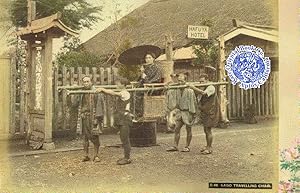
![Seller image for [Reflection in the Mirror]. for sale by Shapero Rare Books](https://pictures.abebooks.com/inventory/md/md10234499460.jpg)
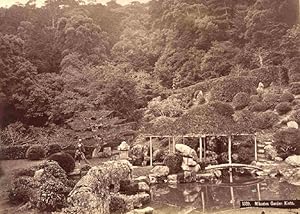
![Seller image for [Smoking Coolie]. for sale by Shapero Rare Books](https://pictures.abebooks.com/inventory/md/md10234499717.jpg)
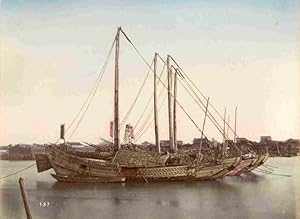
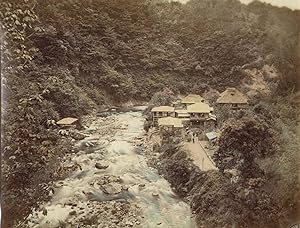
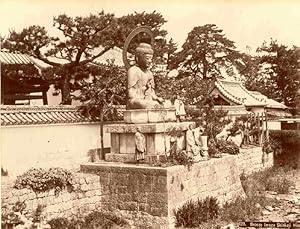
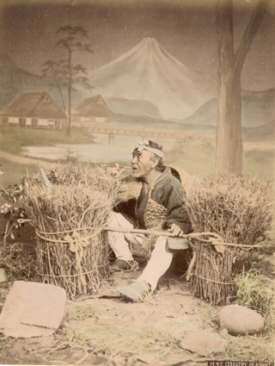
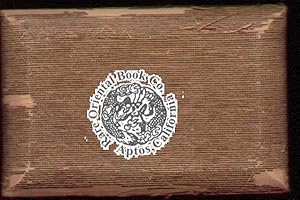
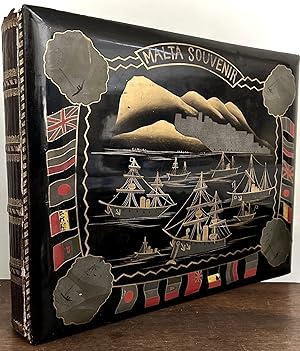
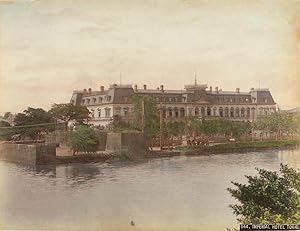
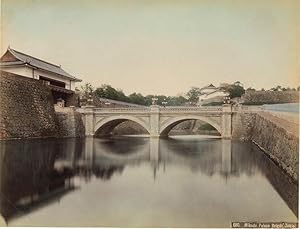
![Seller image for B 1098 HOME BATHING. [Shows Three Semi-Nude Japanese Women In The Ofuro [Bath] + for sale by RARE ORIENTAL BOOK CO., ABAA, ILAB](https://pictures.abebooks.com/inventory/md/md31642474993.jpg)
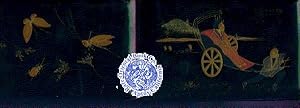
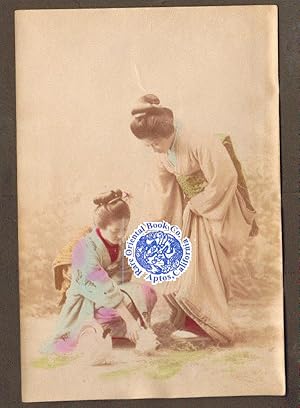
![Seller image for [PHOTOALBUM - JAPAN]. A Japanese lacquer album with fifty hand-coloured photographs. About 1880s. for sale by Charlotte Du Rietz Rare Books (ILAB)](https://pictures.abebooks.com/inventory/md/md12328375271.jpg)